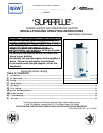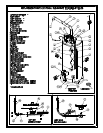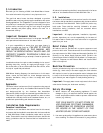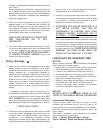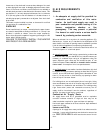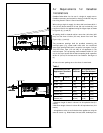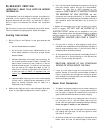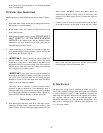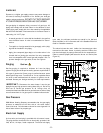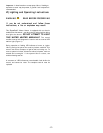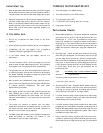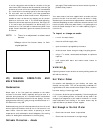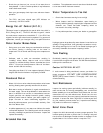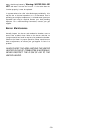
-3-
the aged, or the disabled where water temperatures exceed
125° F (52°C).
Use anti-scald valves in the hot water system to reduce the
risk of scalding at points of use such as lavatories, sinks and
bathing facilities. Such precautions must be followed when
this heater is operated in combination with dishwashing or
space heating applications.
Ø As with all fuel burning equipment, this heater requires an
adequate supply of air for combustion and ventilation. An
insufficient air supply can result in poor combustion or the
recirculation of the exhaust flue gases. Such a condition can
cause sooting or present a fire hazard, which may result in
serious bodily harm or death from asphyxiation.
MAKE SURE THE FLOW OF COMBUSTION
AND VENTILATION AIR IS NOT
RESTRICTED.
Ø If this water heater has been exposed to flooding, freezing,
fire or any unusual condition, do not put it into operation until
it has been inspected and approved by a qualified
professional. THESE CONDITIONS CAN RESULT
IN UNSEEN INTERNAL DAMAGE and are not
subject to warranty coverage.
Safety Warnings
Ø There is a risk in using fuel-burning appliances such as water
heaters. Areas that may not be suitable for water heater
installation include those where flammable liquids, gasoline,
solvents, adhesives, etc., or engine-driven equipment or
vehicles are stored, operated or repaired. Due to the nature
of air movement, flammable vapors can be carried some
distance from the point of storage. The gas-fired water
heater, pilot or main burner flame can ignite these vapors
causing a flashback fire or explosion which may result in
serious personal injury or death, as well as severe property
damage.
If installation in a garage or shed is the only option, it is
recommended that the water heater be elevated a minimum
of 18" (45 cm) above the floor level. This may reduce BUT
NOT ELIMINATE the risk of flammable vapors being
ignited. Such installations must be protected from impact or
physical damage caused from moving equipment or vehicles.
CHECK LOCAL CODES!
Ø Exposure to air borne chemicals can cause severe corrosion
to the water heater and damage to the venting parts. Air
containing vapors from cleaning solvents, pool chemicals,
refrigerator or air conditioning refrigerants, laundry
detergents or bleaches, waxes, spray can propellants, dry
cleaning, photo processing liquids, calcium and sodium chloride
(softener salt) or other process chemicals are typical of
compounds which are potentially corrosive.
Ø Products of this type should not be stored near the heater.
Air containing these chemicals should not be used as supply
to the heater. If necessary, uncontaminated air shall be
obtained from remote or outside sources.
Ø HYDROGEN GAS CAN BE PRODUCED IN A
HOT WATER SYSTEM. THIS CAN BE
PROBLEMATIC IN SYSTEMS WITH LONG
STANDBY PERIODS. HYDROGEN GAS IS
EXTREMELY FLAMMABLE To reduce the risk of
injury under these conditions, it is recommended that the hot
water faucet be opened for several minutes at the kitchen
sink before using any electrical appliance connected to the
hot water system. If hydrogen is present, there will probably
be an unusual sound, such as air escaping through the pipe as
the water begins to flow. THERE SHOULD BE NO
SMOKING, OR OPEN FLAME NEAR THE
FAUCET AT THE TIME THAT IT IS OPEN.
INSTALLATION INSTRUCTIONS
NOTICE
Before installing this water heater consideration and planning
must be given to the following details:
Ø Heater location. The vent blower can create air noise. Do not
install near sleeping area, in a bedroom or bathroom;
Ø Location of the outside vent terminal; See “Venting” p. 7.
Ø Routing and support of the vent piping; Figure 5 page 8.
Ø How and where to obtain combustion and ventilation air
supply; See “Air Requirements” page 4.
Ø Position of water supply and placement of water piping for
hot and cold water; See “Water Connections” page 10.
Ø Access for gas supply, electrical power, floor drain and
service. See “Gas Service” pages 10 and 11.
NOTICE
REVIEW SAFETY WARNINGS FOUND IN THE
FRONT OF THIS MANUAL BEFORE PROCEEDING.
Location and Clearances
Locate the water heater such that all controls are easily
accessible. We recommend that 24" (0.6 m) in front of the
heater and 34" (0.9 m) above be maintained for serviceability.
Ensure that the water heater is level. See Figure 1. Page 1. and
Figure 2 page 4.
This heater is designed to safely operate with the following
minimum clearances to combustibles.
Front 2" (50 mm) Sides and Rear1" (25 mm)
Top 12" (305 mm) Plastic Vent Piping 0" (0.0 mm)



